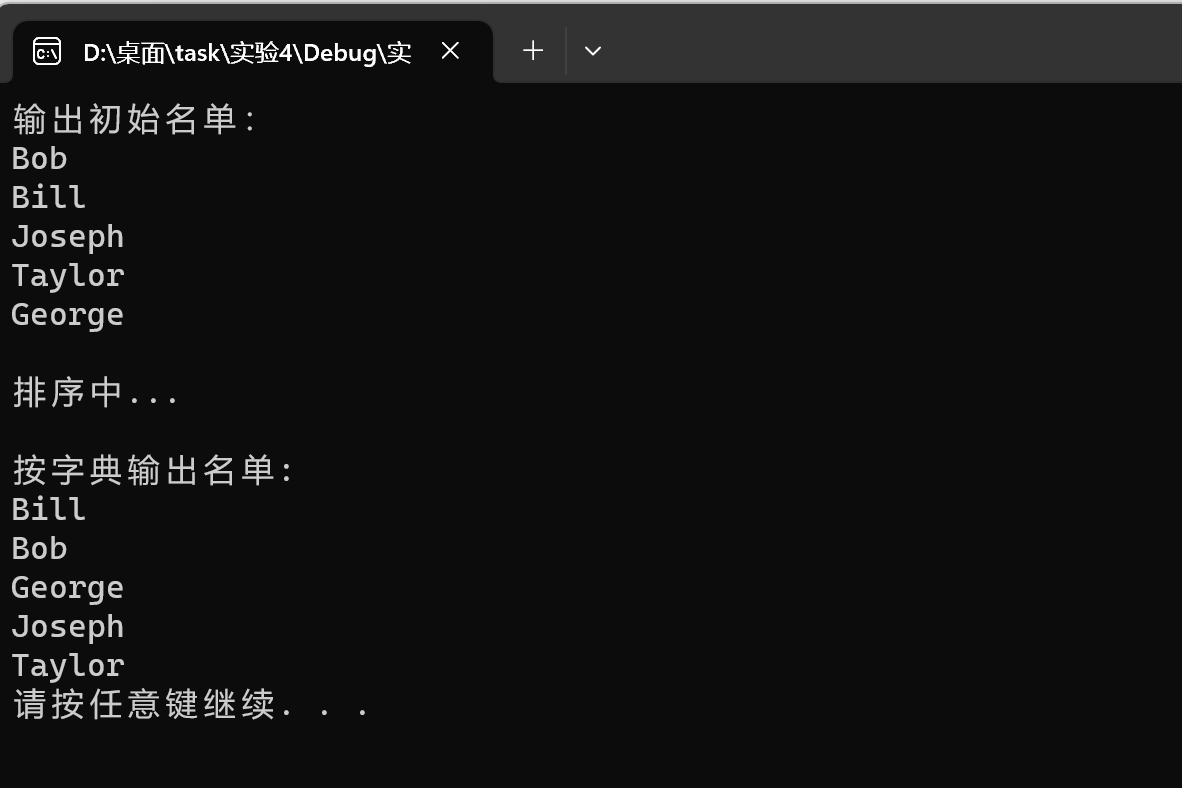实验四
实验1.1运行代码
#include<stdio.h>
#define N 4
int main() {
int a[N] = {2, 0, 2, 3};
char b[N] = {'2', '0', '2', '3'};
int i;
printf("sizeof(int) = %d\n", sizeof(int));
printf("sizeof(char) = %d\n", sizeof(char));
printf("\n");
// 输出int型数组a中每个元素的地址、值
for (i = 0; i < N; ++i)
printf("%p: %d\n", &a[i], a[i]);//%p输出十六进制形式地址
printf("\n");
// 输出char型数组b中每个元素的地址、值
for (i = 0; i < N; ++i)
printf("%p: %c\n", &b[i], b[i]);
printf("\n");
// 输出数组名a和b对应的值
printf("a = %p\n", a);
printf("b = %p\n", b);
system("pause");
return 0;
}
运行截图
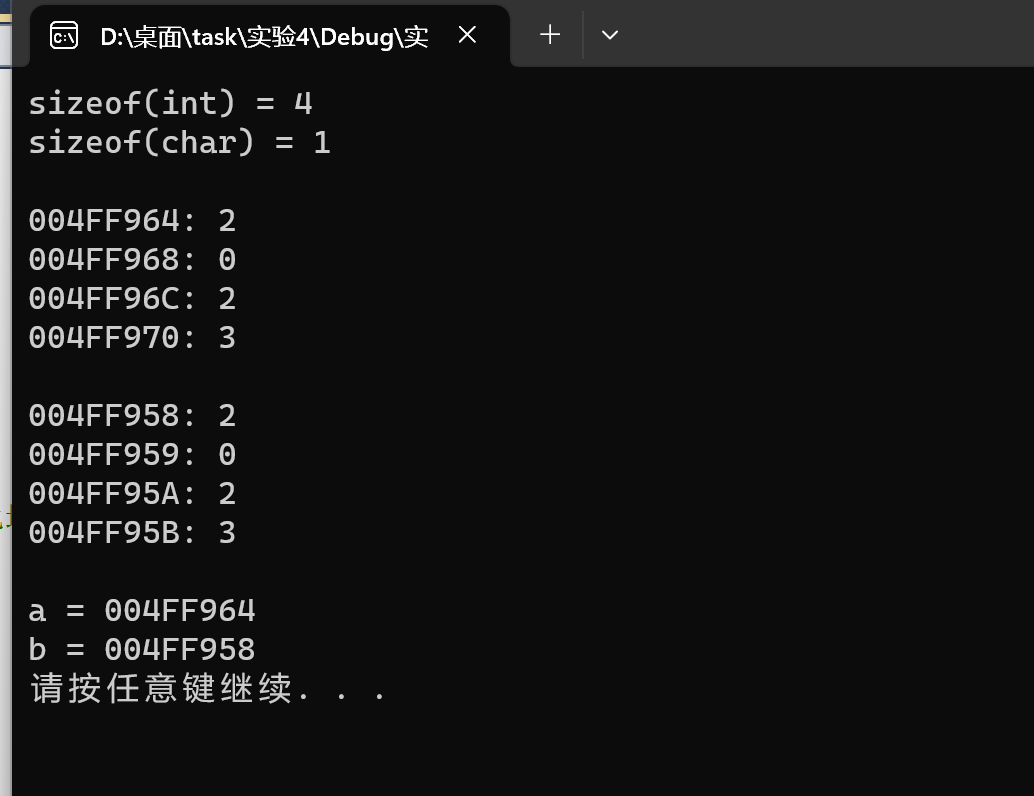
回答问题:
int型是连续存放,每个元素占用4个字节
char型是连续存放,每个元素占用1个字节
一样的
实验1.2运行代码
#include <stdio.h>
#define N 2
#define M 3
int main() {
int a[N][M] = {{1, 2, 3}, {4, 5, 6}};
char b[N][M] = {{'1', '2', '3'}, {'4', '5', '6'}};
int i, j;
// 输出int型二维数组a中每个元素的地址、值
for (i = 0; i < N; ++i)
for (j = 0; j < M; ++j)
printf("%p: %d\n", &a[i][j], a[i][j]);
printf("\n");
// 输出int型二维数组名a, 以及,a[0], a[1]的值
printf("a = %p\n", a);
printf("a[0] = %p\n", a[0]);
printf("a[1] = %p\n", a[1]);
printf("\n");
// 输出char型二维数组b中每个元素的地址、值
for (i = 0; i < N; ++i)
for (j = 0; j < M; ++j)
printf("%p: %c\n", &b[i][j], b[i][j]);
printf("\n");
// 输出char型二维数组名b, 以及,b[0], b[1]的值
printf("b = %p\n", b);
printf("b[0] = %p\n", b[0]);
printf("b[1] = %p\n", b[1]);
printf("\n");
system("pause");
return 0;
}
运行截图

回答问题:
int型数组是按行连续存放,每个元素占用4个字节
一样的
char型数据是按行连续存放,每个元素占用1个字节
一样的
a[0]即第一行第一列地址,a[1]即第二行第一列地址,b[0],b[1]也有相同规律
实验2运行代码
#include <stdio.h>
#include <string.h>
#define N 80
void swap_str(char s1[N], char s2[N]);
void test1();
void test2();
int main() {
printf("测试1: 用两个一维维数组,实现两个字符串交换\n");
test1();
printf("\n测试: 用二维数组,实现两个字符串交换\n");
test2();
system("pause");
return 0;
}
void test1() {
char views1[N] = "hey, C, I hate u.";
char views2[N] = "hey, C, I love u.";
printf("交换前: \n");
puts(views1);
puts(views2);
swap_str(views1, views2);
printf("交换后: \n");
puts(views1);
puts(views2);
}
void test2() {
char views[2][N] = {"hey, C, I hate u.", "hey, C, I love u."};
printf("交换前: \n");
puts(views[0]);
puts(views[1]);
swap_str(views[0], views[1]);
printf("交换后: \n");
puts(views[0]);
puts(views[1]);
}
void swap_str(char s1[N], char s2[N]) {
char tmp[N];
strcpy(tmp, s1);
strcpy(s1, s2);
strcpy(s2, tmp);
}
运行截图
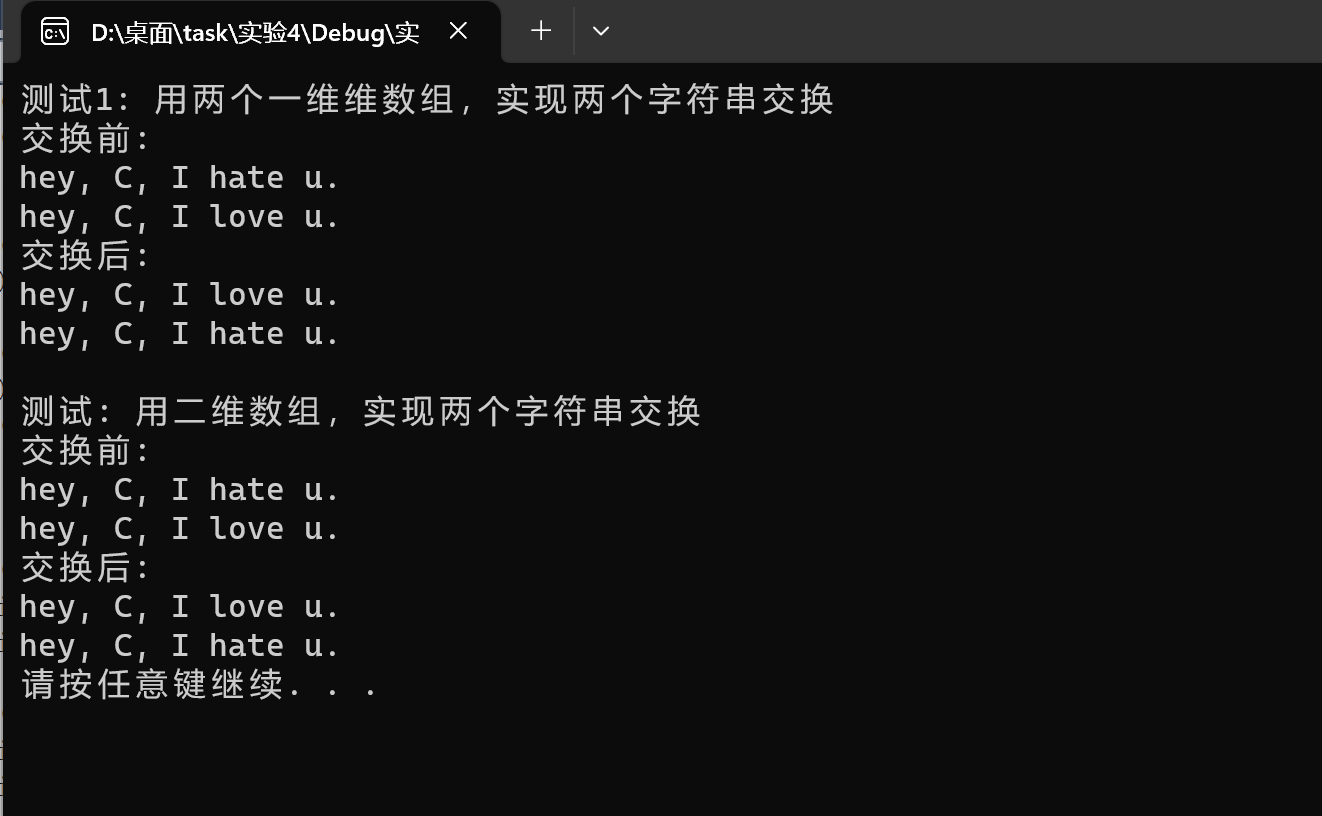
回答问题:若函数模块的形参是一维数组,则可直接调用,若不是,则调用其中一行加一个中括号实现。
实验3.1运行代码
/*
从键盘输入一行英文文本,统计英文单词总数
为了简化问题处理,只考虑单词以空格间隔的情形
对教材例5.22代码做了些微改动:
1. 统计单词个数,编写成函数模块;增加了多组输入
2. 去掉了不必要的中间变量
*/
#include <stdio.h>
#define N 80
int count(char x[]);
int main() {
char words[N+1];
int n;
while(gets(words) != NULL) {
n = count(words);
printf("单词数: %d\n\n", n);
}
return 0;
}
int count(char x[]) {
int i;
int word_flag = 0; // 用作单词标志,一个新单词开始,值为1;单词结束,值为0
int number = 0; // 统计单词个数
for(i = 0; x[i] != '\0'; i++) {
if(x[i] == ' ')
word_flag = 0;
else if(word_flag == 0) {
word_flag = 1;
number++;
}
}
return number;
}
运行截图
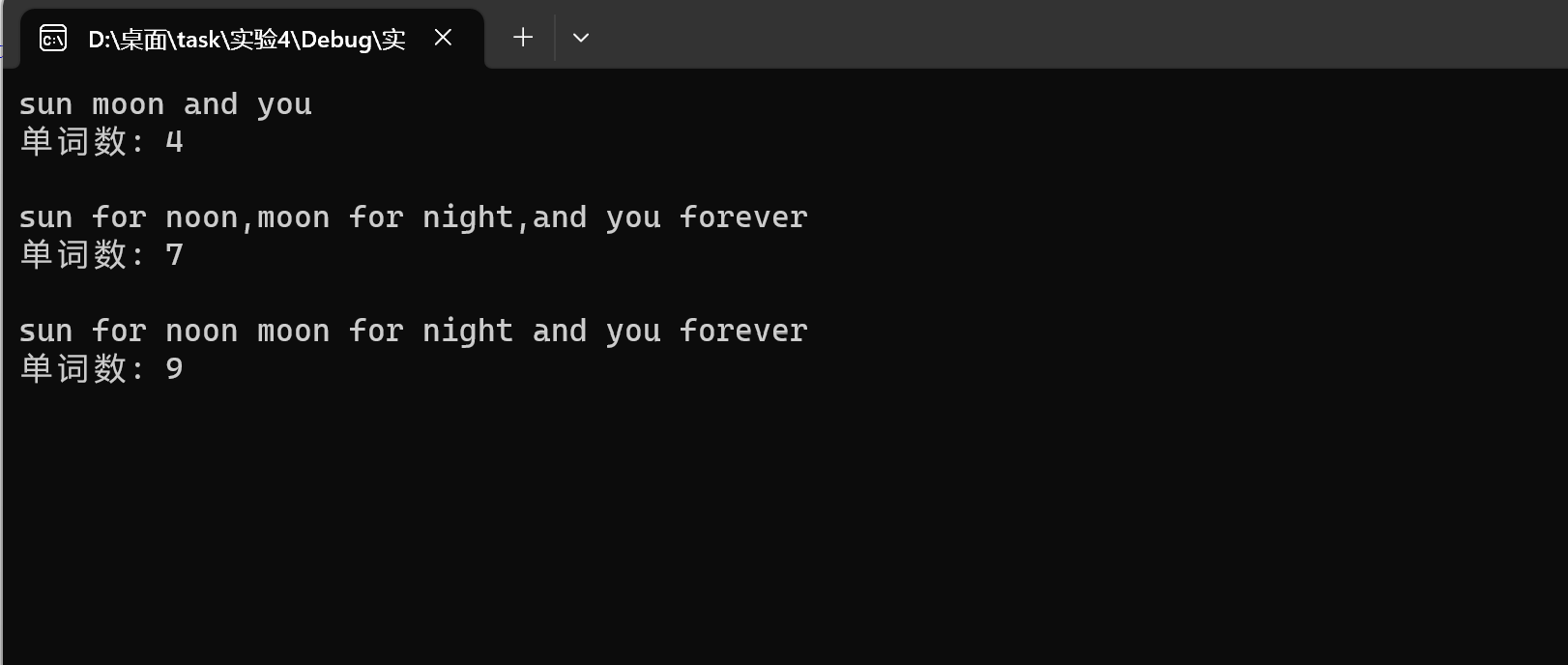
实验3.2运行代码
/*
输入一行英文文本,统计最长单词,并打印输出。
为简化问题,只考虑单词之间用空格间隔的情形。
相较于教材例5.24,做了以下改动:
1. 增加了多组输入,因此,一些变量初始化放到了第一层循环里面
2. 微调了代码书写逻辑和顺序
*/
#include <stdio.h>
#define N 1000
int main() {
char line[N];
int word_len; // 记录当前单词长度
int max_len; // 记录最长单词长度
int end; // 记录最长单词结束位置
int i;
while(gets(line) != NULL) {
word_len = 0;
max_len = 0;
end = 0;
i = 0;
while(1) {
// 跳过连续空格
while(line[i] == ' ') {
word_len = 0; // 单词长度置0,为新单词统计做准备
i++;
}
// 在一个单词中,统计当前单词长度
while(line[i] != '\0' && line[i] != ' ') {
word_len++;
i++;
}
// 更新更长单词长度,并,记录最长单词结束位置
if(max_len < word_len) {
max_len = word_len;
end = i; // end保存的是单词结束的下一个坐标位置
}
// 遍历到文本结束时,终止循环
if(line[i] == '\0')
break;
}
// 输出最长单词
printf("最长单词: ");
for(i = end - max_len; i < end; ++i)
printf("%c", line[i]);
printf("\n\n");
}
return 0;
}
运行截图
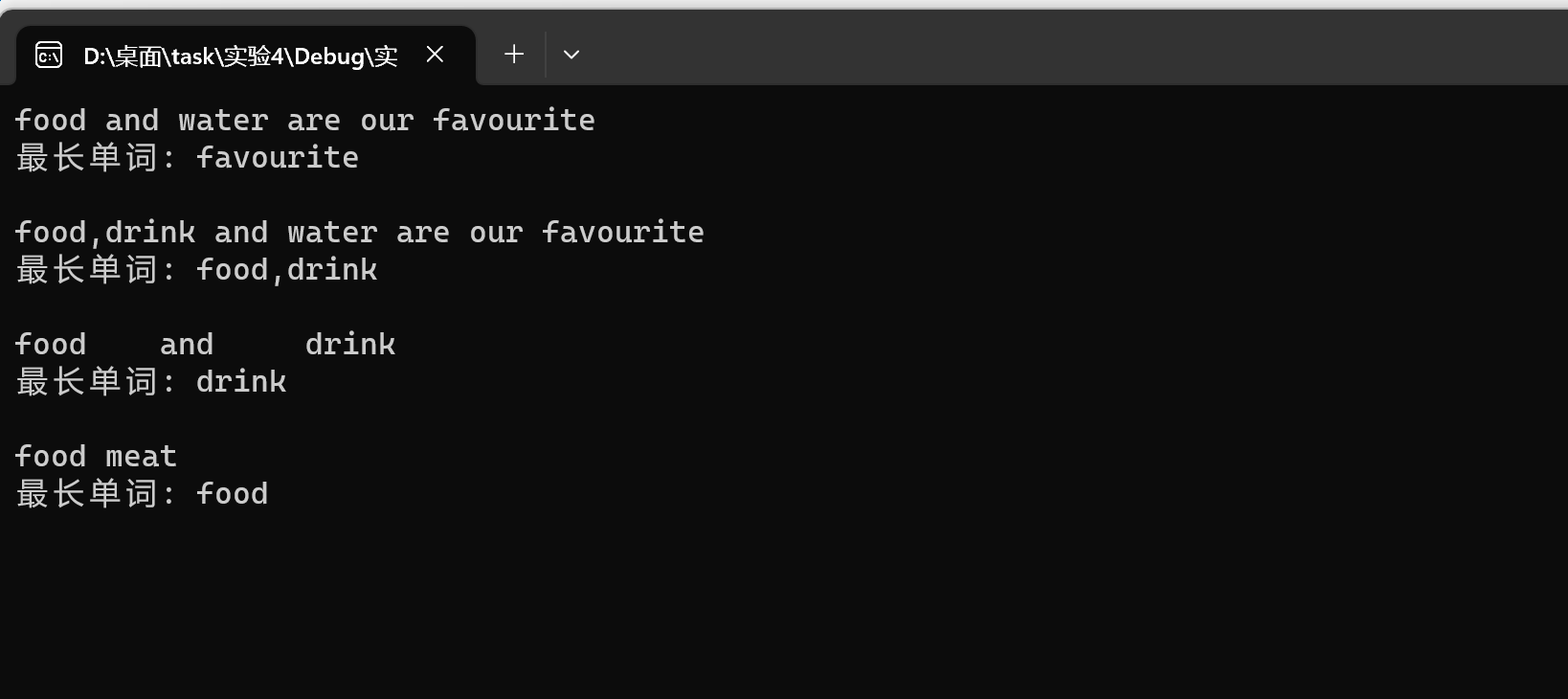
回答问题:先将标点符号化为空格,再通过本源代码实现。
实验4运行代码
#include <stdio.h>
#define N 5
// 函数声明
void input(int x[], int n);
void output(int x[], int n);
double average(int x[], int n);
void bubble_sort(int x[], int n);
int main() {
int scores[N];
double ave;
printf("录入%d个分数:\n", N);
input(scores, N);
printf("\n输出课程分数: \n");
output(scores, N);
printf("\n课程分数处理: 计算均分、排序...\n");
ave = average(scores, N);
bubble_sort(scores, N);
printf("\n输出课程均分: %.2f\n", ave);
printf("\n输出课程分数(高->低):\n");
output(scores, N);
system("pause");
return 0;
}
// 函数定义
// 输入n个整数保存到整型数组x中
void input(int x[], int n) {
int i;
for(i = 0; i < n; ++i)
scanf("%d", &x[i]);
}
// 输出整型数组x中n个元素
void output(int x[], int n) {
int i;
for(i = 0; i < n; ++i)
printf("%d ", x[i]);
printf("\n");
}
// 计算整型数组x中n个元素均值,并返回
// 补足函数average()实现
// ×××
double average(int x[], int n)
{
int sum=0,i;
double pingjun;
for(i=0;i<n;i++)
sum=sum+x[i];
pingjun=(double)(sum/n);
return pingjun;
}
// 对整型数组x中的n个元素降序排序
// 补足函数bubble_sort()实现
// ×××
void bubble_sort(int x[], int n)
{
int i,j,t;
for(j=0;j<N-1;j++)
for(i=0;i<N-j-1;i++)
if(x[i]<x[i+1])
{t=x[i];
x[i]=x[i+1];
x[i+1]=t;
}
for(i=0;i<N;i++)
printf("%d",x[i]);
}
运行截图
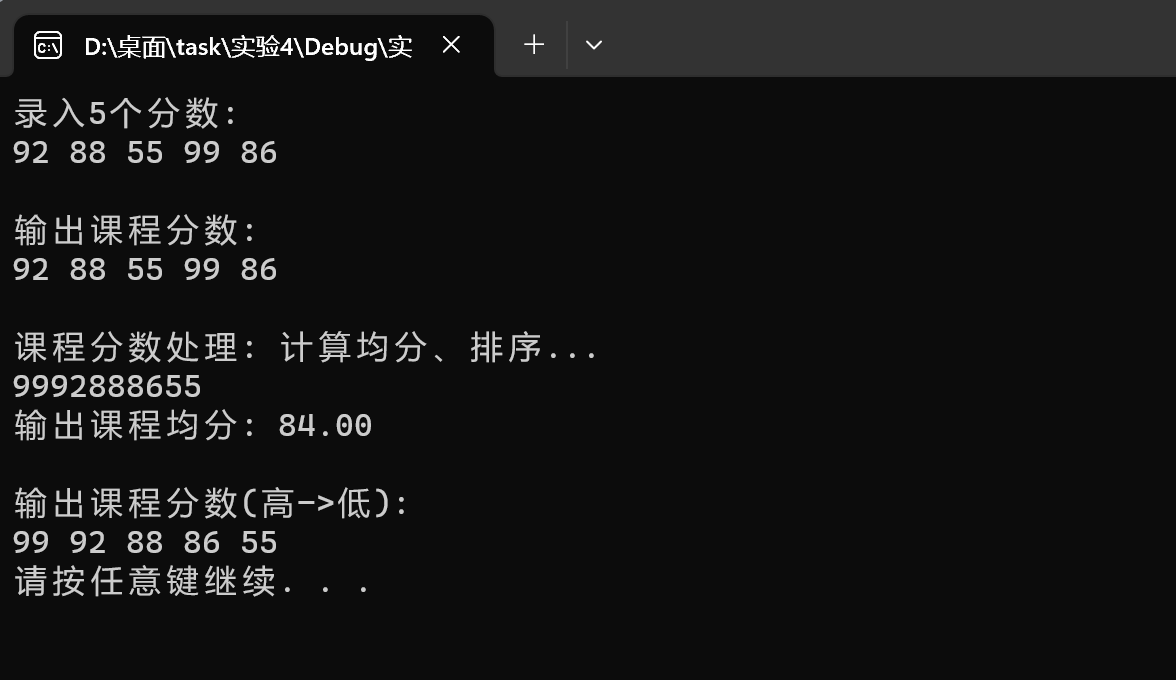
实验5运行代码
#include <stdio.h>
#define N 100
void dec2n(int x, int n); // 函数声明
int main() {
int x;
printf("输入一个十进制整数: ");
while(scanf("%d", &x) != EOF) {
dec2n(x, 2); // 函数调用: 把x转换成二进制输出
dec2n(x, 8); // 函数调用: 把x转换成八进制输出
dec2n(x, 16); // 函数调用: 把x转换成十六进制输出
printf("\n输入一个十进制整数: ");
}
return 0;
}
void dec2n(int x, int n)
{ int count=0,j,t;
int a[100];
do{t=x%n;
a[i]= t;
x=x/n;
count++;}
while(x!=0);
for(j=count-1;j>=0;j--)
printf("%d",a[j]);
printf("\n");
}
// 函数定义
// 功能: 把十进制数x转换成n进制,打印输出
// 补足函数实现
// ×××
运行截图
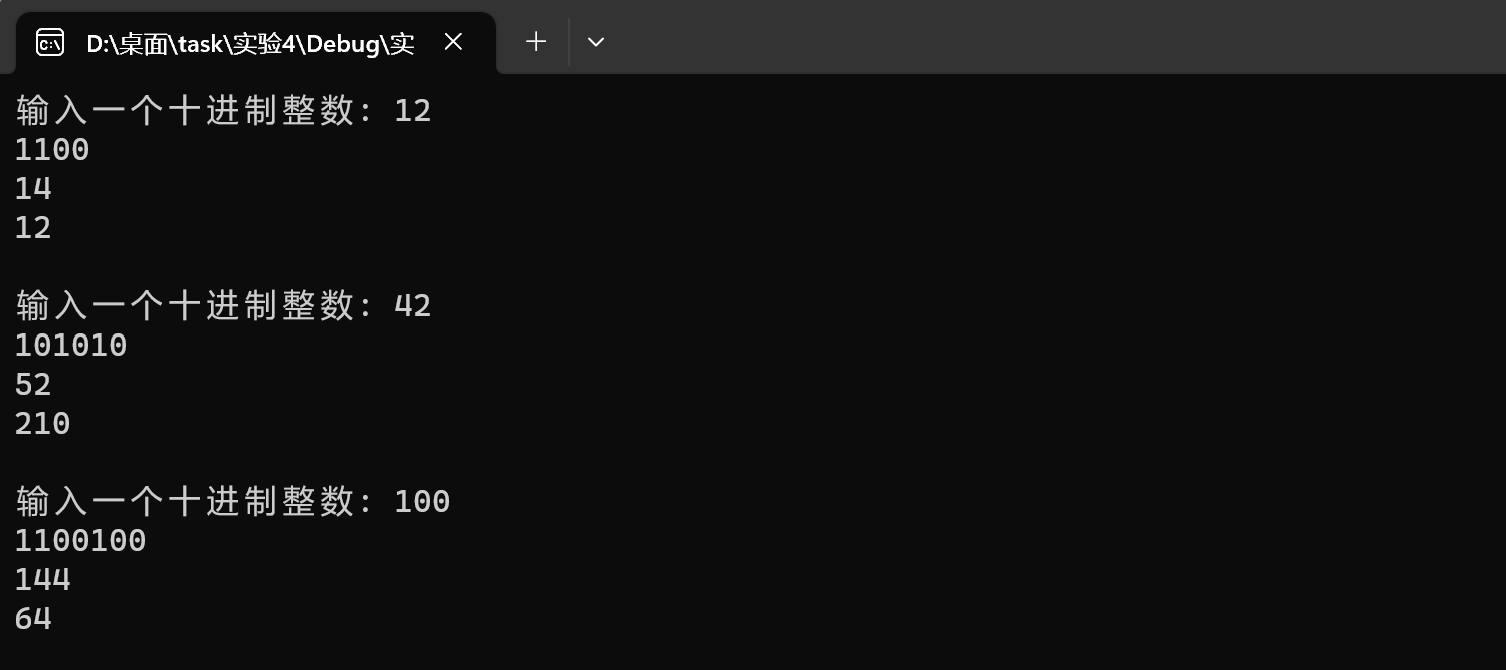
实验6运行代码
#include<stdio.h>
#define N 100
#define M 4
void output(int x[][N], int n);
void rorate_to_right(int x[][N],int n);
int main(){
int t[][N] = {{21,12,13,24},
{25,16,47,38},
{29,11,32,54},
{42,21,33,10}};
printf("原始矩阵:\n");
output(t,M);//函数调用
rorate_to_right(t,M);
printf("变换后的矩阵:\n");
output(t,M);
system("pause");
return 0;}
// 函数定义
// 功能: 输出一个n*n的矩阵x
void output(int x[][N], int n) {
int i, j;
for (i = 0; i < n; ++i) {
for (j = 0; j < n; ++j)
printf("%4d", x[i][j]);
printf("\n");
}
}
// 待补足3:函数rotate_to_right()定义
// 功能: 把一个n*n的矩阵x,每一列向右移, 最右边被移出去的一列绕回左边
// xxx
void rorate_to_right(int x[][N],int n)
{int t,i,j;
for(i=0;i<n;i++)
{t=x[i][n-1];
for(j=n-1;j>0;j--)
x[i][j]=x[i][j-1];
x[i][0]=t;}
}
运行截图
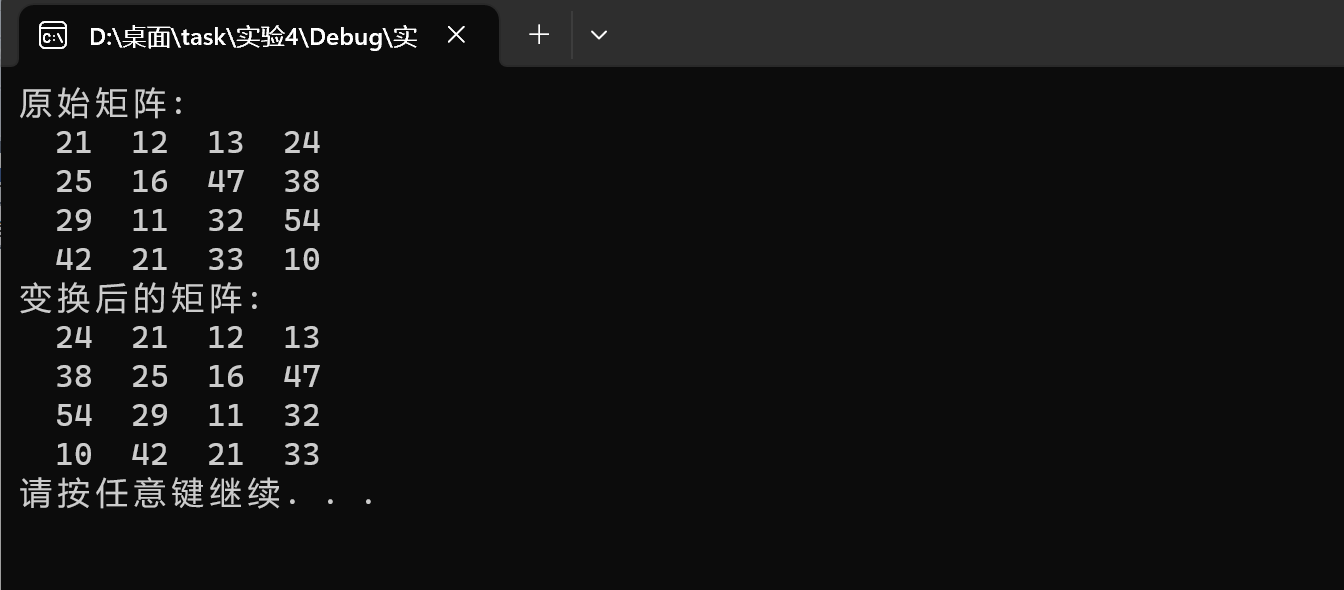
实验7.1运行代码
#include <stdio.h>
#define N 80
void replace(char x[], char old_char, char new_char); // 函数声明
int main() {
char text[N] = "c programming is difficult or not, it is a question.";
printf("原始文本: \n");
printf("%s\n", text);
replace(text, 'i', '*'); // 函数调用 注意字符形参写法,单引号不能少
printf("处理后文本: \n");
printf("%s\n", text);
system("pause");
return 0;
}
// 函数定义
void replace(char x[], char old_char, char new_char) {
int i;
for (i = 0; x[i] != '\0'; ++i) // 思考: '\0'是什么,为什么能作为循环结束条件
if (x[i] == old_char)
x[i] = new_char;
}
运行截图

回答问题:replace是把i换成*
'\0'是空字符,也是字符串结束字符,因为当'\0'出现时,系统将不会往下读后面的字符
实验7.2运行代码
#include <stdio.h>
#define N 80
int main() {
char str[N], ch;
int i;
printf("输入字符串: ");
gets(str);
printf("输入一个字符: ");
ch = getchar();
printf("截断处理......");
i = 0;
while (str[i] != '\0') {
if (str[i] == ch)
break; // blank1
i++;// blank2
}
str[i] = '\0'; // blank3
printf("\n截断处理后字符串: %s\n", str);
system("pause");
return 0;
}
运行截图
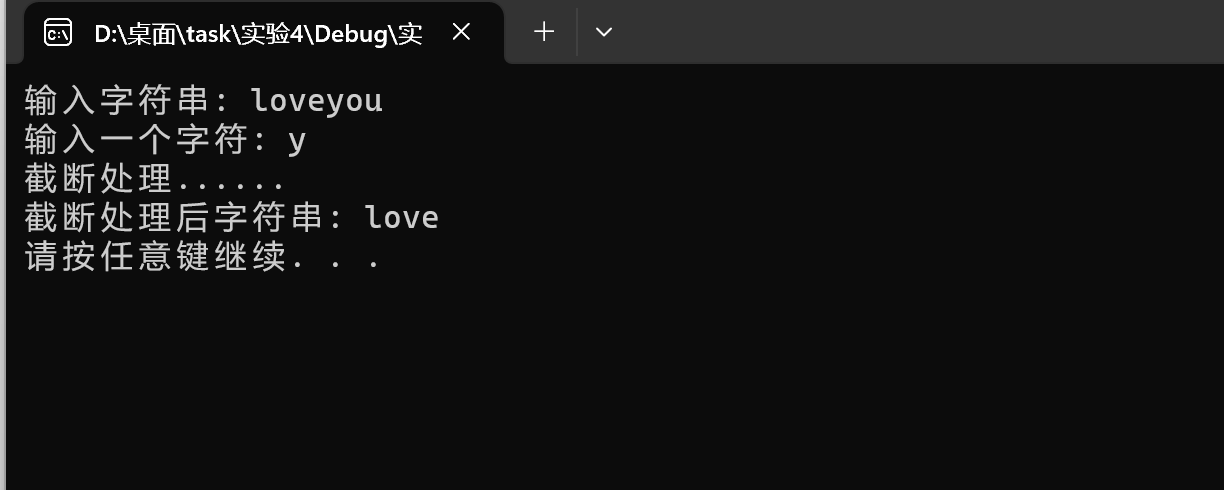
实验8运行代码
#include <stdio.h>
#include <string.h>
#define N 5
#define M 20
void bubble_sort(char str[][M], int n);
int main(){
char name[][M] ={"Bob" , "Bill" , "Joseph" , "Taylor" , "George"};
int i;
printf("输出初始名单:\n");
for(i=0;i<N;i++)
printf("%s\n", name[i]);
printf("\n排序中...\n");
bubble_sort(name, N);//函数调用
printf("\n按字典输出名单:\n");
for(i=0;i<N;i++)
printf("%s\n", name[i]);
system("pause");
return 0;}
void bubble_sort(char str[][M], int n)
{ int i,j;
char temp[M];
for(i=0;i<N;i++)
for(j=i+1;j<N;j++){
if(strcmp(str[i], str[j])>0)
{strcpy(temp, str[i]);
strcpy(str[i],str[j]);
strcpy(str[j],temp);}
}
}
运行截图
